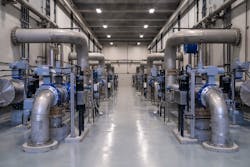James E. Quarles Plant 1 Replacement
Cost: $71.7 million
Location: Marietta, Georgia
Year: 2021-12-21
Size: 33 mgd
Owner: Cobb County-Marietta Water Authority
Designers: Hazen and Sawyer
Contractor: Archer Western Construction LLC
The James E. Quarles Plant 1 Replacement Project replaced the existing plant with a new conventional treatment plant with an initial capacity of 33 million gallons per day (mgd). The original plant was constructed in the 1950s and was demolished entirely to construct the new facility.
The Quarles Plant treats raw water from the Chattahoochee River, distributing clean drinking water to the nearby communities. A key component of the project was managing demolition of the existing plant to allow the new plant to be built while half of the existing plant was still in operation.
“Our team did a lot of pre planning work and pre-construction work to make the project highly constructible,” said Lorrie Tabar, Archer Western/The Walsh Group proposal manager. “We did a lot of 3D modeling so that we could virtually construct the project before we actually construct the project. It helped significantly in coming to decisions and expediting the decision making process.”
Archer Western identified possible conflicts and adapted accordingly to mitigate downtime during the construction process with this modeling. Due to COVID-19 interrupting supply chains, there was a lot of juggling and rescheduling as well. Maintenance of the plant was also a big issue, but the team managed it handily so that communities did not experience an interruption of the service.
Partial demolition of the existing Plant No. 1 was planned and staged to avoid affecting other plant operations essential to Cobb County’s water supply. The site had to be divided and existing facilities protected and buttressed during the demolition and construction.
Complex subterranean pipe chambers and structures had to be constructed in variable subsurface materials ranging from soil to rock, which required special attention during excavation and backfilling to reduce the effect of dissimilar bearing materials and conditions on the new pipes and structures.
For half of the old plant to remain in partial service, a temporary control room was designed to house the existing plant’s PLC control panels and computer workstations until the remaining half of the plant could be demolished. This allowed the owner to use a portion of the existing facility if demand required it while the new facility was under construction.
“We were proactive in reaching out to the community and doing good public relations and notifying the public of when construction was at all going to be around in their area,” Tabar said. There wasn’t really any disruption of traffic per say, because the facility was set well enough from main roadways. One of their big points was noise mitigation and odor mitigation. This project did a lot to improve that.”
Numerous additions included but were not limited to a new raw water transmission main with a flow meter and flow control valve; a new raw water splitter box; as well as three new hydraulic flocculation basins and three sedimentation basins; eight dual media filters with air scour backwash and a plant drain pump station are other vital additions to the plant.
The associated site work, including earthwork, yard piping, storm water control, and site electrical work have also revitalized the plant and its surrounding areas. Navigating these improvements through so many moving parts of was difficult, Tabar said, but the project’s goals were accomplished and ultimately served the community well.
The project finished on budget and the team worked with the owner to determine and implement cost-effective construction methods, and mitigation of possible schedule impacts. Although the project did finish behind the original schedule, several major and necessary components of work were added and approved by the owner, including a large site landscaping package, replacement of the new plant’s raw water Venturi meter, and multiple architectural changes.
Project Year: 2021-12-21Contractor: Archer Western Construction LLCDesigners: Hazen and SawyerOwner: Cobb County-Marietta Water AuthorityLocation: Marietta, GeorgiaCost: $71.7 millionSize: 33 mgd